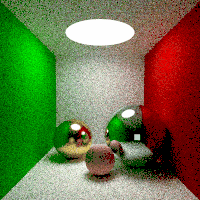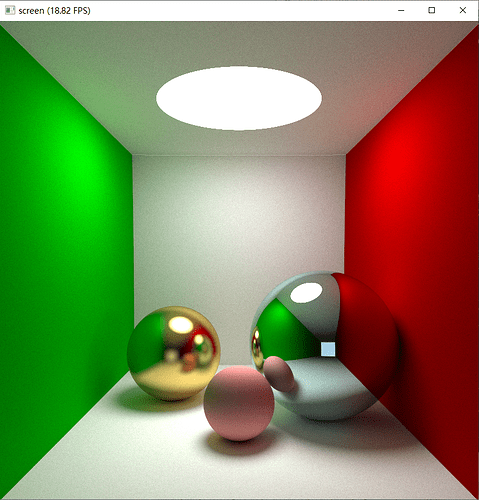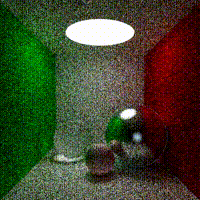参考 https://raytracing.github.io/ 实现了一个实时光线追踪渲染器。
不太熟悉taichi,写得不怎么优雅。
只包含漫反射和金属材质,其实还有个玻璃材质,懒得写了。
对于场景物体与射线相交检测,也没有用任何加速方法。
在我的Metal后端(Radeon Pro 580X 8 GB显卡)上,300*300分辨率只能跑2帧…
所以标题里的实时其实算是有点标题党, ![]()
如果使用CUDA和更好的显卡,估计跑到20帧以上也是有可能的。
欢迎各路大侠跑一跑。
————
补充:
根据一些同学的反馈,目前CUDA的随机数生成很慢,所以建议使用OpenGL或Metal运行这个程序。

import taichi as ti
import math
import random
import time
ti.init(arch=ti.gpu)
# 画布
nx = 300
ny = 300
screen = ti.Vector(3, dt=ti.f32, shape=(nx, ny))
# 相机参数
# 0.6.8版本有kernel里不能将临时Vector变量相加的bug,这里使用零维张量
lookfrom = ti.Vector(3, dt=ti.f32, shape=())
lookat = ti.Vector(3, dt=ti.f32, shape=())
up = ti.Vector(3, dt=ti.f32, shape=())
fov = 60 # 视角
aspect = ny / nx # 长宽比
cam_lower_left_corner = ti.Vector(3, dt=ti.f32, shape=())
cam_horizontal = ti.Vector(3, dt=ti.f32, shape=())
cam_vertical = ti.Vector(3, dt=ti.f32, shape=())
cam_origin = ti.Vector(3, dt=ti.f32, shape=())
# 球体列表,[0]-[2]为圆心,[3]为半径
sphere_num = 9
sphere_origin_list = ti.Vector(3, dt=ti.f32, shape=(sphere_num)) # 球心
sphere_radius_list = ti.var(dt=ti.f32, shape=(sphere_num)) # 半径
sphere_material_list = ti.var(dt=ti.i32,
shape=(sphere_num)) # 材质,1=漫反射,2=金属,3=光源
sphere_material_color_list = ti.Vector(3, dt=ti.f32,
shape=(sphere_num)) # 材质颜色
sphere_metal_fuzz_list = ti.var(dt=ti.f32, shape=(sphere_num)) # 金属光泽度
sphere_origin_list[0] = [0, -0.2, -1.5]
sphere_radius_list[0] = 0.3
sphere_material_list[0] = 1
sphere_material_color_list[0] = [0.8, 0.3, 0.3]
sphere_origin_list[1] = [-0.8, 0.2, -1]
sphere_radius_list[1] = 0.7
sphere_material_list[1] = 2
sphere_material_color_list[1] = [0.6, 0.8, 0.8]
sphere_metal_fuzz_list[1] = 0.0
sphere_origin_list[2] = [0.7, 0, -0.5]
sphere_radius_list[2] = 0.5
sphere_material_list[2] = 2
sphere_material_color_list[2] = [0.8, 0.6, 0.2]
sphere_metal_fuzz_list[2] = 0.2
# 光源
sphere_origin_list[3] = [0, 5.4, -1]
sphere_radius_list[3] = 3
sphere_material_list[3] = 3
sphere_material_color_list[3] = [10, 10, 10]
# 地面
sphere_origin_list[4] = [0, -100.5, -1]
sphere_radius_list[4] = 100
sphere_material_list[4] = 1
sphere_material_color_list[4] = [0.8, 0.8, 0.8]
# 屋顶
sphere_origin_list[5] = [0, 102.5, -1]
sphere_radius_list[5] = 100
sphere_material_list[5] = 1
sphere_material_color_list[5] = [0.8, 0.8, 0.8]
# 背
sphere_origin_list[6] = [0, 1, 101]
sphere_radius_list[6] = 100
sphere_material_list[6] = 1
sphere_material_color_list[6] = [0.8, 0.8, 0.8]
# 右
sphere_origin_list[7] = [-101.5, 0, -1]
sphere_radius_list[7] = 100
sphere_material_list[7] = 1
sphere_material_color_list[7] = [0.6, 0.0, 0.0]
# 左
sphere_origin_list[8] = [101.5, 0, -1]
sphere_radius_list[8] = 100
sphere_material_list[8] = 1
sphere_material_color_list[8] = [0.0, 0.6, 0.0]
lookfrom[None] = [0.0, 1.0, -5.0]
# 归一化
@ti.func
def normalization(v):
k = 1 / (v.norm())
return k * v
# 生成相机参数
@ti.func
def generate_cam_parameter():
# lookfrom[None] = [0.0, 1.0, -5.0]
lookat[None] = [0.0, 1.0, -1.0]
up[None] = [0.0, 1.0, 0.0]
theta = fov * (math.pi / 180.0)
half_height = ti.tan(theta / 2.0)
half_width = aspect * half_height
cam_origin[None] = lookfrom[None]
w = normalization(lookfrom[None] - lookat[None])
u = normalization(up[None].cross(w))
v = w.cross(u)
cam_lower_left_corner[None] = ti.Vector([-half_width, -half_height, -1.0])
cam_lower_left_corner[
None] = cam_origin - half_width * u - half_height * v - w
cam_horizontal[None] = 2 * half_width * u
cam_vertical[None] = 2 * half_height * v
@ti.func
def random_in_unit_sphere():
p = 2.0 * ti.Vector([ti.random(), ti.random(),
ti.random()]) - ti.Vector([1, 1, 1])
while (p[0] * p[0] + p[1] * p[1] + p[2] * p[2] >= 1.0):
p = 2.0 * ti.Vector(
[ti.random(), ti.random(), ti.random()]) - ti.Vector([1, 1, 1])
return p
# 生成光线
@ti.func
def cam_get_ray(u, v):
return cam_origin, cam_lower_left_corner[
None] + u * cam_horizontal[None] + v * cam_vertical[None] - cam_origin
@ti.func
def reflect(v, n):
return v - 2 * v.dot(n) * n
@ti.func
def scatter(ray_origin, ray_direction, hit_p, hit_normal, hit_material,
hit_fuzz):
scattered_ray_origin = hit_p
scattered_ray_direction = ti.Vector([0.0, 0.0, 0.0])
flag = False
if hit_material == 1: # 漫反射
target = hit_p + hit_normal + random_in_unit_sphere()
scattered_ray_direction = target - hit_p
flag = True
elif hit_material == 2: # 金属
reflected = reflect(normalization(ray_direction), hit_normal)
scattered_ray_direction = reflected + hit_fuzz * random_in_unit_sphere(
) # 后一项为光泽度
flag = scattered_ray_direction.dot(hit_normal) > 0
else:
pass
return flag, scattered_ray_origin, scattered_ray_direction
@ti.func
def hit_sphere(sphere_center, sphere_radius, ray_origin, ray_direction, t_min,
t_max):
oc = ray_origin - sphere_center
a = ray_direction.dot(ray_direction)
b = oc.dot(ray_direction)
c = oc.dot(oc) - sphere_radius * sphere_radius
discriminant = b * b - a * c
hit_flag = False
hit_t = 0.0
hit_p = ti.Vector([0.0, 0.0, 0.0])
hit_normal = ti.Vector([0.0, 0.0, 0.0])
if discriminant > 0.0:
temp = (-b - ti.sqrt(b * b - a * c)) / a
if temp < t_max and temp > t_min:
hit_t = temp
hit_p = ray_origin + hit_t * ray_direction
hit_normal = (hit_p - sphere_center) / sphere_radius
hit_flag = True
if hit_flag == False:
temp = (-b + ti.sqrt(b * b - a * c)) / a
if temp < t_max and temp > t_min:
hit_t = temp
hit_p = ray_origin + hit_t * ray_direction
hit_normal = (hit_p - sphere_center) / sphere_radius
hit_flag = True
return hit_flag, hit_t, hit_p, hit_normal
@ti.func
def hit_all_spheres(ray_origin, ray_direction, t_min, t_max):
hit_anything = False
hit_t = 0.0
hit_p = ti.Vector([0.0, 0.0, 0.0])
hit_normal = ti.Vector([0.0, 0.0, 0.0])
hit_material = 1
hit_material_color = ti.Vector([0.0, 0.0, 0.0])
hit_fuzz = 0.0
closest_so_far = t_max
for i in range(sphere_num):
hit_flag, temp_hit_t, temp_hit_p, temp_hit_normal = \
hit_sphere(sphere_origin_list[i], sphere_radius_list[i], ray_origin, ray_direction, t_min, closest_so_far)
if hit_flag:
hit_anything = True
closest_so_far = temp_hit_t
hit_t = temp_hit_t
hit_p = temp_hit_p
hit_normal = temp_hit_normal
hit_material = sphere_material_list[i]
hit_material_color = sphere_material_color_list[i]
hit_fuzz = sphere_metal_fuzz_list[i]
return hit_anything, hit_t, hit_p, hit_normal, hit_material, hit_material_color, hit_fuzz
@ti.func
def color(ray_origin, ray_direction):
col = ti.Vector([0.0, 0.0, 0.0])
coefficient = ti.Vector([1.0, 1.0, 1.0])
for i in range(10):
hit_flag, hit_t, hit_p, hit_normal, hit_material, hit_material_color, hit_fuzz = \
hit_all_spheres(ray_origin, ray_direction, 0.001, 10e9)
if hit_flag:
if hit_material == 3: # 光源
col = coefficient * hit_material_color
break
flag, ray_origin, ray_direction = \
scatter(ray_origin, ray_direction, hit_p, hit_normal, hit_material, hit_fuzz)
if flag:
coefficient *= hit_material_color # 衰减
else:
break
else:
unit_direction = normalization(ray_direction)
t = 0.5 * (unit_direction.y + 1.0)
col = (1.0 - t) * ti.Vector([1.0, 1.0, 1.0]) + t * ti.Vector(
[0.5, 0.7, 1.0])
col *= coefficient
break
return col
@ti.kernel
def draw():
if lookfrom[None][0] < 1.0:
lookfrom[None][0] += 0.1
else:
lookfrom[None][0] = -1.0
generate_cam_parameter()
for i, j in screen:
col = ti.Vector([0.0, 0.0, 0.0])
for s in range(100):
u = float(i + ti.random()) / float(nx) # random是为抗锯齿
v = float(j + ti.random()) / float(ny)
ray_origin, ray_direction = cam_get_ray(u, v)
col += color(ray_origin, ray_direction)
col /= float(100)
col = ti.sqrt(col)
screen[i, j] = col
gui = ti.GUI("screen", (nx, ny))
for i in range(10000):
draw()
gui.set_image(screen.to_numpy())
gui.show()
# ti.imwrite(screen, 'raytracing'+str(i)+'.png')



